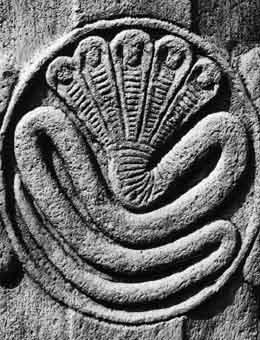| ==The
Laws of Manu== This is the text
(c.1st c. CE?) that Dr. Ambedkar loved to hate; he and
other Dalit protesters were later to burn it. The Laws
of Manu explains that in the beginning of the
universe the great abstract principle of Brahman created
all things, including the four Varnas or ranked
caste-groups: 'for the sake of the prosperity of the
worlds, he caused the Brahmin, the Kshatriya, the
Vaishya, and the Shudra to proceed from his mouth, his
arms, his thighs, and his feet' (I,31).... 'But in order
to protect this universe He, the most resplendent one,
assigned separate (duties and) occupations to those who
sprang from his mouth, arms, thighs, and feet' (I,87).
At the top of this fourfold system is the Brahmin: 'As
the Brahmin sprang from (Brahman's) mouth, as he was the
first-born, and as he possesses the Veda, he is
by right the lord of this whole creation' (I,93). At the
bottom is the Shudra: 'One occupation only the lord
prescribed to the Shudra: to serve meekly even these
(other) three castes [varnas]' (I,91). Above all, the
contrast between the two extremes of the hierarchy is
made clear: 'But a Shudra, whether bought or unbought,
he [=a Brahmin] may compel to do servile work; for he
was created by the Self-existent (Svayambhu) to be the
slave of a Brahmin' (VIII,413).
Outside the system
entirely were the 'slaves' [dasyus]: 'All those tribes
in this world, which are excluded from (the community
of) those born from the mouth, the arms, the thighs,
and the feet (of Brahman), are called Dasyus, whether
they speak the language of the Mlechchhas (barbarians)
or that of the Aryans' (X,45). Among those outside the
system are groups produced by illicit unions among the
different varnas, who 'shall subsist by occupations
reprehended by the twice-born [=the three upper
varnas]' (X,46). Among these occupations are 'catching
and killing (animals) living in holes', 'working in
leather' (X,49), 'carry[ing] out the corpses (of
persons) who have no relatives' (X,55), and
'execut[ing] criminals' (X,56). These impure groups
are to live in remote, wild areas or 'near well-known
trees and burial grounds' (X,50). 'Their dress (shall
be) the garments of the dead, (they shall eat) their
food from broken dishes, black iron (shall be) their
ornaments, and they must always wander from place to
place' (X,52). 'A man who fulfils a religious duty,
shall not seek intercourse with them; their
transactions (shall be) among themselves, and their
marriages with their equals' (X,53). 'Their food shall
be given to them by others (than an Aryan giver) in a
broken dish; at night they shall not walk about in
villages and in towns' (X,54). The translation here is
Buehler's (1886), the one that Dr. Ambedkar himself
used: *one site*; *another site*.
|
